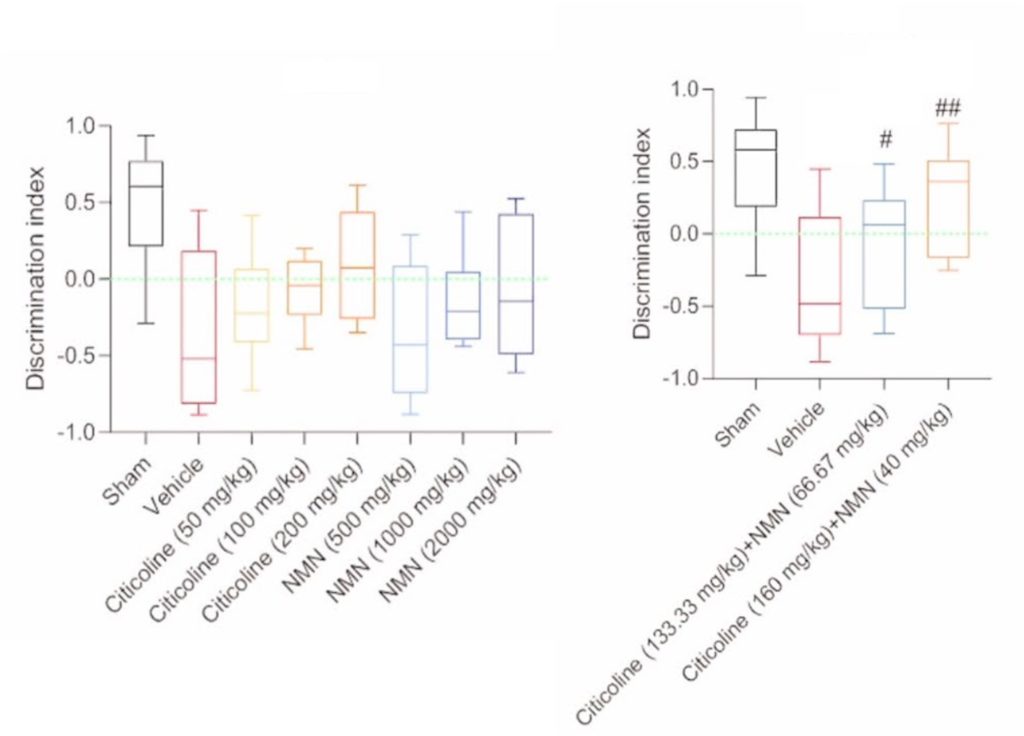NMN and Citicoline Synergistically Shield Against Memory Decline, Study Finds
NMN combined with citicoline — a precursor to healthy brain fat — counteracts cognitive impairment, inflammation, and brain damage in a rat model for dementia.
Highlights:
- NMN and citicoline synergistically improve the memory of rats with vascular dementia (VD) — dementia from lack of blood flow to the brain.
- Combined NMN and citicoline reduce the activation of inflammation-promoting microglia cells — the brain’s resident immune cells.
- NMN combined with citicoline reduces damage to the white matter tracts of the brain.
Vascular dementia (VD) is considered the second most common type of dementia after Alzheimer’s, especially in North America and Europe. The risk of VD increases with age, so safeguards to limit this risk are crucial. Now, researchers from Hangzhou Normal University in China may have found such a safeguard.
As reported in Cellular and Molecular Neurobiology, Zhao and colleagues show that NMN and citicoline work synergistically to mitigate memory loss in VD rats. They also show that NMN and citicoline reduce inflammation and brain damage, revealing how the combination of these anti-aging compounds may provide greater cognitive protection than if they were taken separately. The authors conclude,
“We have proved that the combination of citicoline and NMN in [VD] rats would maintain the normal physical condition of neurons, inhibit neuroinflammation in the brain, and ultimately attenuate the white matter damage and cognitive dysfunction of [VD] rats.”
NMN and Citicoline Combined Deter Vascular Dementia
To model VD, Zhao and colleagues surgically hindered blood flow to the brains of rats. Without sufficient blood, brain tissue begins to deteriorate, and the hippocampus is particularly vulnerable. Hence, these VD rats showed deficits in key aspects of cognition — learning and memory.
To determine the effects of NMN and citicoline, the researchers first administered each anti-aging compound separately to the VD rats. Using the novel object recognition test — a method for studying memory in rodents — the researchers found that neither NMN nor citicoline alone significantly improved the learning and memory of the rats. However, administering NMN and citicoline together led to synergetic improvements in memory.

(Zhao et al., 2023 | Cell. Mol. Neurobiol.) NMN and Citicoline Synergistically Improve Cognition. The discrimination index (DI) scores the ability of rodents to discriminate between new and familiar objects. Higher DI scores indicate improved learning and memory. Whereas NMN and citicoline alone did not improve DI scores (left), combining the two supplements significantly increased DI scores in vascular dementia rats (denoted by #s, right). Sham = normal rats, and Vehicle = vascular dementia rats that received no treatment.
The primary physiological defect underlying VD is inflammation, so Zhoa and colleagues assessed this hallmark of aging via measuring microglia cells. When activated, microglia promote inflammation that could cause brain damage. The results showed that NMN combined with citicoline reduced microglia activation by nearly 3-fold, suggesting a reduction in brain inflammation.

(Zhao et al., 2023 | Cell. Mol. Neurobiol.) NMN and Citicoline Combined Reduce Brain Inflammation. A marker for activated microglia called Iba-1 was found in fewer cells within the brains of vascular dementia rats (BCCAO) treated with NMN and citicoline compared to untreated rats, suggesting reduced brain inflammation.
When more microglia are activated in the brain we see more brain inflammation which causes damage to myelin — a layer of fat that insulates and protects our neurons. Since myelin appears as white matter at the macroscopic level, damage to myelin can disrupt white matter integrity. Zhao and colleagues found that VD rats had reduced white matter integrity. However, NMN combined with citicoline protected against this brain damage.

(Zhao et al., 2023 | Cell. Mol. Neurobiol.) NMN and Citicoline Combined Reduce Brain Damage. Reduced white matter integrity, an indicator of brain damage, was apparent in untreated (red) vascular dementia rats (BCCAO). However, vascular dementia rats treated with NMN and citicoline (orange) had less severe reductions in white matter integrity, suggesting protection against damage.
Overall, the findings of Zhao and colleagues suggest that NMN and citicoline combined synergistically protect against VD by reducing inflammation-induced brain damage. Furthermore, since inflammation-induced brain degeneration is a common feature of brain aging, this anti-aging combination could slow or prevent the general brain deterioration that occurs with aging.
The Cognitive Boosting Effects of NMN and Healthy Brain Fats
In the brain, citicoline maintains a brain fat (lipid) called phosphatidylcholine (PC) and improves the survival of neurons. PC and other brain fats are known to contribute to the prevention of cognitive decline in humans. Furthermore, NMN has previously been shown to improve the cognition of aged rats and rats with vascular dementia. Together, these studies give credence to citicoline and NMN improving the cognition of humans, but this has not yet been tested.
Model: Male Sprague-Dawley rats with occluded carotid arteries to induce vascular dementia
Dosage: Intraperitoneal injection of 160 mg/kg of citicoline and 40 mg/kg NMN

